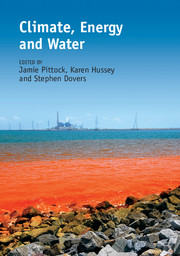Book contents
- Frontmatter
- Contents
- List of contributors
- Acknowledgements
- 1 Justifying, extending and applying “nexus” thinking in the quest for sustainable development
- 2 Water resources, climate change and energy
- 3 Implications of climate change for energy systems in a multisectoral context
- 4 Fossil fuels and water: A complex and evolving relationship
- 5 Renewable energy and water
- 6 Hydropower within the climate, energy and water nexus
- 7 Water and biofuels
- 8 Trade-offs and synergies between water and energy use in rural Australia
- 9 Management of the urban energy-water nexus
- 10 Managing the electricity-water nexus in China, France, India and the United States
- 11 Cross-sectoral governance of the climate, energy and water sectors: A ‘Rubik's cube’ analysis of cross-sectoral co-ordination
- 12 Regulation of the nexus
- 13 Climate, energy and water: the potential roles and limitations of markets
- 14 Strategies to mainstream climate change, energy, water and food security nexus knowledge and skills
- 15 A nexus of nexuses: systemic governance for climate response
- 16 Integrated modelling of the energy-water nexus in the American West
- 17 Biodiversity and the climate, energy and water nexus
- 18 Consumers, food supply chain and the nexus
- 19 Future prospects in climate, energy and water research and policy
- Index
12 - Regulation of the nexus
Published online by Cambridge University Press: 05 April 2015
- Frontmatter
- Contents
- List of contributors
- Acknowledgements
- 1 Justifying, extending and applying “nexus” thinking in the quest for sustainable development
- 2 Water resources, climate change and energy
- 3 Implications of climate change for energy systems in a multisectoral context
- 4 Fossil fuels and water: A complex and evolving relationship
- 5 Renewable energy and water
- 6 Hydropower within the climate, energy and water nexus
- 7 Water and biofuels
- 8 Trade-offs and synergies between water and energy use in rural Australia
- 9 Management of the urban energy-water nexus
- 10 Managing the electricity-water nexus in China, France, India and the United States
- 11 Cross-sectoral governance of the climate, energy and water sectors: A ‘Rubik's cube’ analysis of cross-sectoral co-ordination
- 12 Regulation of the nexus
- 13 Climate, energy and water: the potential roles and limitations of markets
- 14 Strategies to mainstream climate change, energy, water and food security nexus knowledge and skills
- 15 A nexus of nexuses: systemic governance for climate response
- 16 Integrated modelling of the energy-water nexus in the American West
- 17 Biodiversity and the climate, energy and water nexus
- 18 Consumers, food supply chain and the nexus
- 19 Future prospects in climate, energy and water research and policy
- Index
Summary
Introduction
The climate-energy-water nexus is a relatively new focus of interdisciplinary research and policy attention (Proust et al 2007; WBCSD 2010; PMSEIC 2010; Water in the West 2013). Research and practice regarding regulation of the nexus is at an even more nascent stage. Nevertheless, regulation – establishing rules, laws, and institutional and decision-making frameworks – is emerging as a critical dimension of managing the trade-offs that arise at the intersection of climate, energy and water policies. On the one hand, well-designed regulation that takes account of all elements of the nexus can facilitate more integrated decision making and management, in some cases leading to outcomes that optimise benefits for all three sectors (Pittock et al. 2013). On the other hand, regulatory systems in different sectors that operate independently of one another – a situation described as “regulatory fragmentation” (Craig 2008) – may present barriers to management of the nexus and to the implementation of innovative technological options.
This chapter examines regulation of the climate-energy-water nexus. It focusses on the barriers to integrated climate-energy-water decision making posed by regulatory fragmentation, as well as case examples of ways that existing regulatory frameworks for climate, energy and water might be adapted to better manage the nexus. Case studies are drawn from specific jurisdictional contexts – Australia, the United States and the European Union – but are analysed as examples of regulatory practice that might offer useful lessons for regulation of the nexus in other regions and countries. The final section of the chapter considers some of the new challenges facing regulatory efforts at the nexus. These include current or imminent developments: for example, the climate change and water impacts of efforts to harvest ‘unconventional’ energy resources, including through the use of techniques of hydraulic fracturing (fracking) (Wiseman 2009; NWC 2010). Other challenges lie on the horizon: for example, the water and energy implications of proposed technologies to deal with carbon pollution and climate change, such as carbon capture and storage (Pittock et al 2013), or geoengineering (Royal Society 2009).
- Type
- Chapter
- Information
- Climate, Energy and Water , pp. 198 - 217Publisher: Cambridge University PressPrint publication year: 2015
- 1
- Cited by



